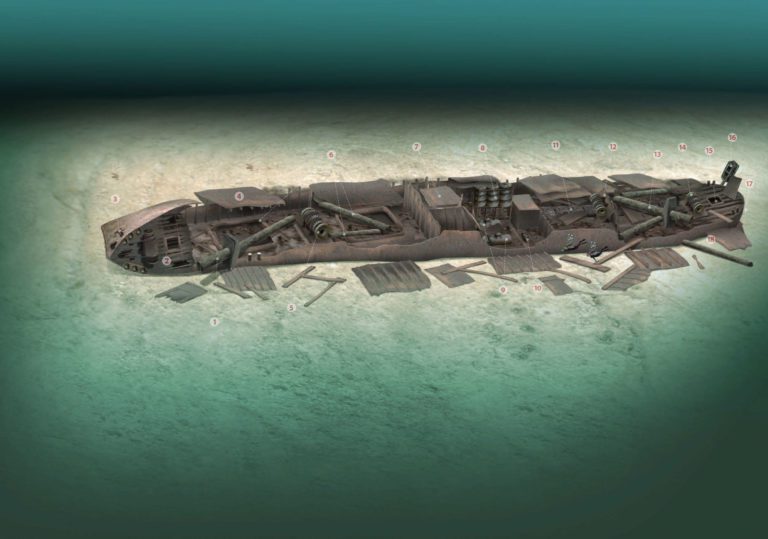This tour off Northern Ireland is a bit of an oddity – a German-built ship torpedoed by a German submarine. JOHN LIDDIARD reports, illustration by MAX ELLIS
THE 2899-TON HUNSDON STARTED life as the Arnfried, built in Bremen in 1911 for the Hamburg Amerika Line. At the start of World War One, the Arnfriedwas captured by the British in German West Africa, and entered British service as the Hunsdon.
The Hunsdon almost survived the war serving the Allied side, being torpedoed just outside Strangford Lough less than a month before the armistice.
A buoyline is usually tied to the forward mast of the wreck (1), so this is where our tour begins. The mast has fallen across the first hold to leave the top of the mast almost next to the bow (2). As often happens when a wreck breaks up, the bow has remained relatively intact, but has fallen onto its port side to
leave the starboard side uppermost, the shallowest point being 33m. In the centre of the bow deck, a small hatch leads below, though easier access is available through the break. Either side, the wooden deck is beginning to decay and leave holes rotted through.
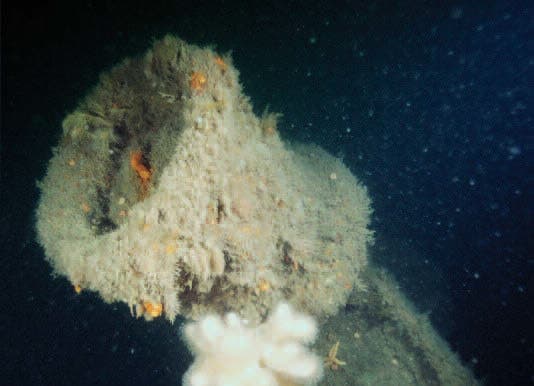
The anchor-winch is still solidly in place, chains leading down the hawse pipes to the anchors, which are secured against the outside of the bow (3).
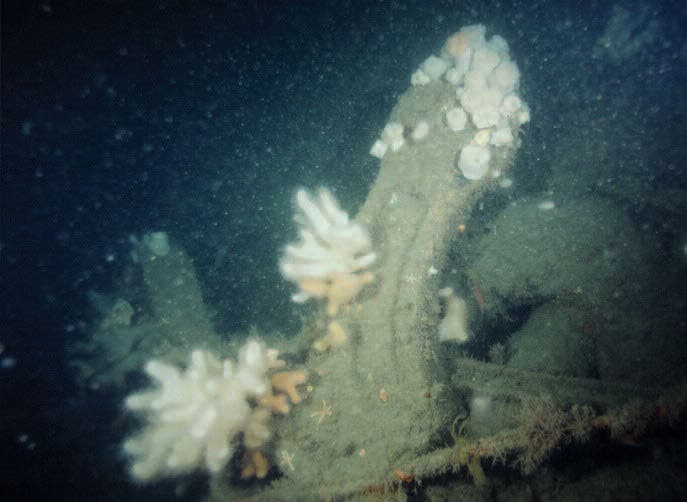
Below the bow, the deepest point of the wreck is in a scour to 38m.
Now heading aft, behind the bow, the deck and hold coamings have fallen into the wreck at a depth of about 35m, with deck fittings such as bollards and winches still in place.
Some sections of hull remain upright or even slightly overhanging the deck, particularly on the starboard side (4).
Between the forward holds, by the foot of the fallen mast a single large winch spans the deck (5).
The booms of cargo derricks lie forward and aft across the holds (6).
After the second hold, the wreck rises from the seabed with the bulkhead to the stoke hold (7). Gaps in this bulkhead provide glimpses of the three boilers inside. The wheelhouse would have been located above.
The three boilers provided steam to a triple-expansion engine (8), standing upright and reasonably intact along the centre line of the ship.
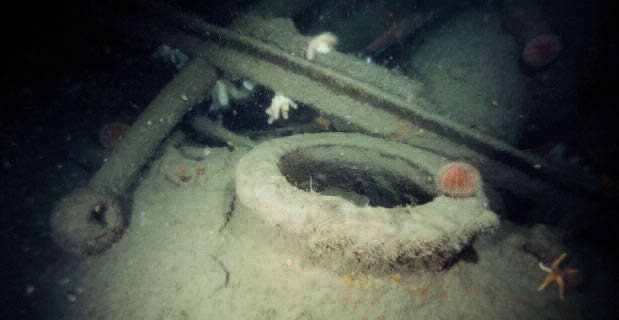
The hull to the starboard side has fallen in towards the engine, while on the port side the hull has fallen out to leave the water tanks exposed (9).
To the aft of the engine-room, a reel with water-hose is intact and standing upright on a deck plate (10).
Back on the centre-line, behind the engine the thrust-bearing is enclosed in a big square box, with the propeller-shaft leading aft in a covered tunnel (11).

As with the forward part of the wreck, the deck has collapsed into the two aft holds, though it is considerably more broken, so that the propshaft tunnel is visible most of the way to the stern.
Between the holds, a single cargo winch has tipped forwards, leaving its base vertical and facing aft (12). The corresponding mast (13) has fallen aft and to port, diagonally across the coaming for the aft hold.
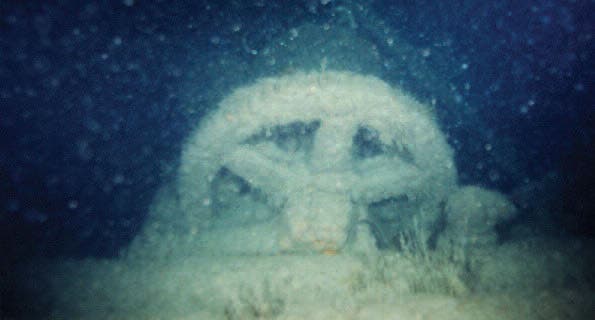
A final cargo winch spans the stern deck (14). This would have served the aftmost hold via small derricks and a goalpost mast, now fallen forward and off the port side beneath the main mast.
Like the bow, the stern is decked in wood, with a small hatch in the centre providing access below (15).
For wartime service, the Hunsdon was fitted with an ‘anti-submarine’ gun at the stern.
This is tipped over the starboard side , its barrel pointing downwards (16). The bore measures about 4in, and allowing for concretion and rust the calibre could be anything within half an inch of this. I have been unable to find any specification.
Dropping to the seabed and then back beneath the stern, the propeller is still in place (17), though well tangled in a trawl net that has been dragged into the stern. The scour beneath the stern reaches 36m.
While at the seabed, a quick swim round to the port side shows the remains of the goalpost masts and associated derricks that would have served the aft hold (18).
Ascent from here depends on what the current is doing. If it is heading back towards the buoy, a drift along the wreck followed by at least the first part of the ascent back up the buoyline may be easiest, even if a delayed SMB is used for the final part of the ascent.
If it is running in the opposite direction, ascent will be easier using a delayed SMB from the stern.
WHY THE MYSTERY?
HUNSDON, cargo steamer. BUILT 1911, SUNK 1918
The 2899-ton Hunsdon steamed out between Kingstown Harbour’s two massive piers into Dublin Bay in the dusk of 10 October, 1918, writes Kendall McDonald. The vessel was on the last leg of a voyage in ballast from Le Havre to Belfast, a voyage she was destined not to complete.
For years afterwards, her loss was said to be a direct result of German espionage.
The Hunsdon, formerly the German ship Arnfried, was built in 1911. She was captured soon after the outbreak of war by British forces at Douala, in German West Africa, and was operated for the rest of the war by the Elder Dempster Line for the Ministry of Transport.
Following out of Kingstown about a mile behind the Hunsdon were the Fleet Auxiliary Industry and her escort, the armed trawler Persian Empire.
No one aboard the two Naval ships heard or saw anything of the incident, but Hunsdon was torpedoed and sunk with the loss of one man at 11.30pm by UB92.
She was three-quarters of a mile south-east of Strangford Light Buoy, County Down, just a mile and a half from the two vessels.
What makes the whole matter more mysterious is that the first to report the loss of the Hunsdon was the Persian Empire. She did that as part of a message that the Industry had been torpedoed and sunk and that she had four survivors aboard from her – as well as 30 survivors from the Hunsdon, all of whom she was taking into Belfast.
Oddly, there is no Admiralty record of the time to say that the Industry was either attacked or sunk, and Hunsdon‘s name was kept on the Fleet list until 1919. And it was not until 1920 that the deaths of six crewmen from the Industry were published as in memoriam notices in their local paper.
No reason for the secrecy was ever given. The Industry was originally HMS Glasgow, and was converted to a naval storeship in 1901.
It was later revealed that she was torpedoed by UB94, commanded by Oberleutnant Haumann, who seems to have been collaborating with UB92 at the time she sank the Hunsdon.
TOUR GUIDE

GETTING THERE: Norfolkline Irish Sea Ferry Services, Liverpool (Birkenhead) to Belfast, 0870 600 4321, norfolkline.com. From Belfast take the A20 to Portaferry.
TIDES: Divers may experience a little current, but the Hunsdon can be dived through the tide. Slack water roughly coincides with high and low water Belfast.
HOW TO FIND IT: The Hunsdon lies with bow to the north at GPS position 54 19.165N, 5 27.285W (degrees, minutes and decimals). Local divers often leave a small buoy attached to the wreck.
DIVING, ACCOMMODATION & AIR: DV Diving Website, 02891 861686 / 464671
QUALIFICATIONS: The dive is right on the limit for a BSAC Sports Diver if you dive at low water and stay out of the scour at either end. Otherwise the depth necessitates BSAC Dive Leader or Advanced Nitrox/ Deco Procedures.
LAUNCHING: RIBs can be launched at the ferry jetty in Portaferry, though care must be taken not to obstruct the ferry.
FURTHER INFORMATION: Admiralty Chart 2156, Strangford Lough. Admiralty Chart 2093, Southern Approaches to North Channel. Shipwreck Index of Ireland, by Richard and Bridget Larn. Shipwrecks of the Ulster Coast by Ian Wilson. Irish Wrecks Online by Randall Armstrong.
PROS: Moderately intact with engine and gun, and it can be dived through the tide.
CONS: Borderline for divers qualified to 30m.
DEPTH RANGE: 35-45m
Click here to view the PDF Version of The Hunsdon Wreck Tour
